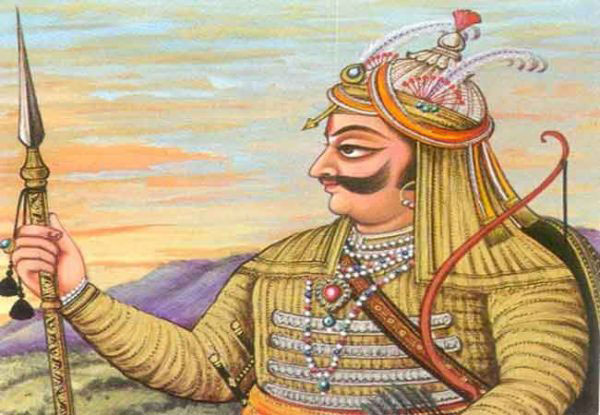The actual founder of the Islamic Empire in the Indian subcontinent was Shahabuddin Muhammad, popularly called Muhammad Ghori. Muhammad Ghori was the Sultan of the Ghurid Empire along with his brother Ghiyath ud-din from c.1173-1202 CE, and the supreme ruler of the Ghurid Empire from c.1202-1206 CE. He was called one of the greatest rulers of the Ghurid dynasty.
Ghurid Dynasty
In c.1173 CE, Muhammad Ghori ascended the throne at Ghazni while his elder brother was ruling at Ghur. Being a very ambitious ruler, was not satisfied with only Ghazni and wanted to expand his empire to get hold of more power and control. He was well aware of India’s political, religious, social, and military weaknesses and also the enormous wealth that India had. It is pertinent to note that unlike Mahmud of Ghazni, Muhammad Ghori was very much interested in establishing a permanent Empire in India and not merely looting its wealth.
Muhammad Ghori (c.1173-1206 CE)
He was the real founder of the Islamic Empire in India. There were as many as seven major invasions of Muhammad Ghori against India, and mostly he emerged as the winner. In c.1175 CE, he led his first expedition against Multan, which was largely successful. In the same campaign, he captured Uchch from the Bhatti Rajputs and established a fort there.
In c.1178 CE, he again marched to conquer Gujarat but the Chalukya ruler of Gujarat, Solanki Bhima II, defeated him at the Battle of Kayadara. But this defeat did not discourage Muhammad Ghori and he realized the necessity of creating a suitable base in Punjab before venturing on the further conquest of India.
The Battle of Gujarat or Kayadara (1178) was a defeat suffered by Muhammad Ghori during his first campaign against a Hindu ruler in India. In 1178 he turned south, and led his army from Multan to Uch and then across the desert towards the Gujarat capital of Anhilwara (modern Patan).
Gujarat was ruled by the young Raja Bhimdev II (ruled 1178-1241), a member of the Solanki dynasty (one of several Chalukya dynasties), although the age of the Raja meant that the army was commanded by his mother Naikidevi. Muhammad’s army had suffered greatly during the march across the desert and Naikidevi inflicted a major defeat on him at the village of Kayadra (near Mount Abu, about forty miles to the north-east of Anhilwara). The invading army suffered heavy casualties during the battle, and also in the retreat back across the desert to Multan.
Muhammad of Ghur never returned to Gujarat. An army led by Qutab al-din Aibek, his deputy in India, invaded in c.1195-97 and plundered the capital, but then returned to Delhi. Gujarat wasn’t annexed by the Sultanate of Delhi until 1297.
First Battle of Terrain (c.1191 CE)

Ghori’s possession of Punjab and his attempt to advance into the Gangetic Doab brought him to direct conflict with a Rajput ruler, Prithviraj Chauhan, who had already overrun many small states in Rajputana, captured Delhi, and wanted to extend with claims of Tabarhinda (Bhatinda). In the first battle fought at Tarain, Ghori’s army was routed and he narrowly escaped death. Prithviraj conquered Bhatinda but he made no efforts to garrison it effectively. This allowed Ghori to re-assemble his forces and make preparation for another advance into India. He thus launched a campaign against the Ghaznavid possessions in Punjab. As a result, he conquered Peshawar c.1179, Sindh in c.1182 CE, Punjab, and Lahore in 1190 CE.
Second Battle of Terrain (c. 1192 CE)
This battle is regarded as one of the turning points in Indian history, as Prithviraj Chauhan was defeated and Ghori emerged successfully. Turkish forces under Ghori were well organized with swift-moving cavalry. The bulky Indian forces were no match against the superior organization, skill, and speed of Turkish cavalry. It is pertinent to note that the Turkish cavalry used two superior technologies, namely the use of horseshoes and the use of iron stirrups. A large number of Indian soldiers were killed. Prithviraj escapes but is later captured near Saraswati.
He was allowed to rule over Ajmer for some time as the coins about this period bear legend “Prithvirajadeva” on one side and the words “Sri Muhammad Sam” on the other side. However, soon after, Prithviraj was executed on the charges of conspiracy. The Turkish army captured the fortresses of Hansi, Saraswati, Samana, Delhi, and Ajmer.
Battle of Chandwar (c. 1194 CE): Ghori defeated Jaichandra (the ruler of Kannauj) of the Gahadavalas dynasty. Thus, the battles of Tarain and Chandwar laid the foundations of Turkish rule in Northern India. After this invasion, Qutub-ud-din Aibak was made the viceroy of Muhammad Ghori. After this, Ghori returned to Ghazni to carry out his conquests in the western frontiers, leaving the affairs of India in the hand of trusted slave general Qutab-ud-din Aibak, who continued his conquests in India.
Revolt of Khokhars (c.1205 CE): Ghori had to again come to India to crush the revolt of the Khokhars. However, in 1206 CE, Ghori was killed by someone near the Dhamyak district of Jhelum (now in Pakistan) while going back to Ghazni. This reign of India passed on to Aibak, who the foundation of the Slave Dynasty.

